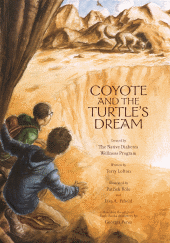 |
Canku Ota
|
 |
|
(Many Paths)
|
||
|
An Online Newsletter
Celebrating Native America
|
||
|
December
1, 2011 - Volume 9 Number 12
|
||
|
|
||
|
Eagle Books
Expands to Middle School Students to Teach about Diabetes
|
||
|
by Centers for Disease
Control and Prevention
|
||
|
To encourage readership and healthy choices among middle schoolers, their families and communities, the novels employ entertainment-education (EE) as a communication strategy. Applying EE principles, the books appeal to middle schoolers by using the genres that have proven successful with this audience—adventure, fantasy, and mystery. The stories use relationships and emotion to lend authenticity and context to the character’s motivations and behaviors. EE-based storytelling creates believable characters that can serve as effective role models for healthy living. EE promotes problem-solving at community and individual levels, an extremely important ability for an age group that is exploring its own sense of independence and self-efficacy. Added to this formula is the most important EE element, the seamless interweaving of health and educational messaging into the plot. In Coyote and the Turtle’s Dream, type 2 diabetes prevention messages about healthy eating, being physically active, and following traditional wisdom become part of the story itself. Moreover, Rain and his friends apply both Native and western science to avert the disruption of the reservation’s ecology, an implicit metaphor for maintaining metabolic balance in the human body. About the Book Searching for the meaning of the dream, Rain seeks the help of Boomer (Thunder Cloud), Simon, and Hummingbird. Unknowingly, the four friends are drawn into the coyote’s game and the criminal activities of a dangerous fossil poaching ring. Deep within the gullies of Shell Ridge, an escarpment that borders the bed of an ancient sea, Rain follows Coyote to a mysterious cave where he discovers the origins of the reservation’s water and confronts the notorious fossil thief, Vernon Smeed—risking everything to save one that he loves. With his pranks and deceptions, Coyote puts Rain through many tests. The trickster teaches the boy lessons that will last a lifetime, but he, too, learns an important truth—Sky Heart has chosen well. The great bird has entrusted his messages about health and the wisdom of Native knowledge to a remarkable boy whose strength is founded in the steadfastness of friends and love of family. Free copies of Coyote and the Turtle’s Dream may be ordered by clicking here: http://wwwn.cdc.gov/pubs/Diabetes.aspx or by calling 1-800-CDC-INFO. |
|
|
||
|
|
||
| Canku Ota is a free Newsletter celebrating Native America, its traditions and accomplishments . We do not provide subscriber or visitor names to anyone. Some articles presented in Canku Ota may contain copyright material. We have received appropriate permissions for republishing any articles. Material appearing here is distributed without profit or monetary gain to those who have expressed an interest. This is in accordance with Title 17 U.S.C. Section 107. | ||
|
Canku Ota is a copyright ©
2000, 2001, 2002, 2003, 2004, 2005, 2006, 2007, 2008, 2009, 2010,
2011 of Vicki Barry and Paul Barry.
|
||
 |
 |
|
|
The "Canku
Ota - A Newsletter Celebrating Native America" web site and
its design is the
|
||
|
Copyright ©
1999, 2000, 2001, 2002, 2003, 2004, 2005,
2006, 2007, 2008, 2009, 2010, 2011
of Paul C. Barry.
|
||
|
All Rights Reserved.
|
||
 Based
on the popularity of the original Eagle Books series, the Native
Diabetes Wellness Program (NDWP) is developing a series of novels
for middle schoolers in Native communities. The novel, Coyote and
the Turtle’s Dream, is the first in a series of three books
that will include a four-volume graphic novel based on the same
story. The book features characters from the original series, but
also expands the characters to include family members, teachers,
store owners, other residents of a small reservation town, and an
elderly box turtle. Adding to the understanding of type 2 diabetes
presented in the original books, Coyote and the Turtle’s Dream
introduces the character of Arianna, a young girl with type 1 diabetes.
Based
on the popularity of the original Eagle Books series, the Native
Diabetes Wellness Program (NDWP) is developing a series of novels
for middle schoolers in Native communities. The novel, Coyote and
the Turtle’s Dream, is the first in a series of three books
that will include a four-volume graphic novel based on the same
story. The book features characters from the original series, but
also expands the characters to include family members, teachers,
store owners, other residents of a small reservation town, and an
elderly box turtle. Adding to the understanding of type 2 diabetes
presented in the original books, Coyote and the Turtle’s Dream
introduces the character of Arianna, a young girl with type 1 diabetes.